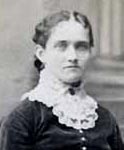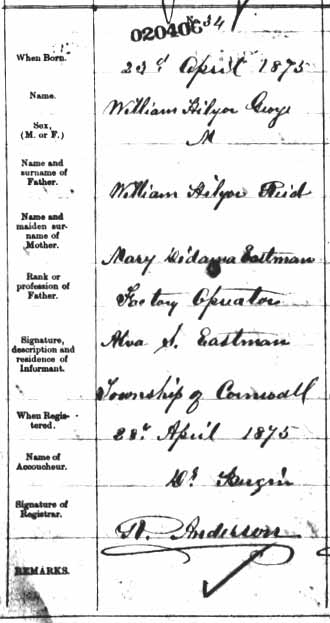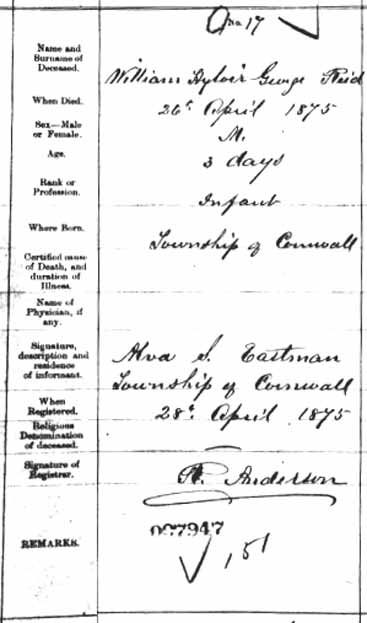Marinda Anna Reed (continued)
©2007 by James W. A. Low.
 |
Chapter 2.
Teenage years from 12 to 19. 1872 to 1879 |
Maturing with Loss and Gain.
At the age of 11, Minnie losses her mother when Delphina A. Taylor/Reed dies of heart disease in 1872 on March 28 at Lowell. A year later, her father remarries Mary Diedamia Eastman at Lowell in 1873 on March 3. Thus, Mary becomes Minnie's stepmother. Mary Eastman was born in Cornwall, Ontario (then Canada West) in 1848 on April 16. While Minnie's mother descended from an American Revolutionary Soldier, her stepmother was an United Empire Loyalist descendant. How William Reed and and Mary Eastman met is unknown, but they were married at Lowell and lived there for a period, although a visit may have been made by the family to Cornwall shortly after marriage. In one of Minnie's high school compositions, she describes a trip to Cornwall. This will be discussed later. It is known that Mary was in Cornwall in 1875. It was known that Minnie's father William Reed was originally a farmer in Maine, then became a Mill Hand/Weaver in Lowell in the 1850s. According to Aunt Grace (Anna Grace Tanner), he was later involved in the paper industry and had to travel as part of his business. He may have had to travel to Cornwall as part of his business.
It is not quite true that Minnie was an "only child." For a period of three days, she had a half brother: William Hellier George Reed who was born at Cornwall, Ontario 1875 April 23, but died just three days later. The informant to the Register was normally the father in cases of births and infant deaths, but this was not the case and it was only after I discovered this that I researched and discovered that his father died before his birth. The informant at both birth and death of the child was Mary's father Alva Schofield Eastman. For some time, this information was missed in research, since the name was spelled wrong. Minnie's father died at Cornwall in 1875 on January 27, about three months before the birth of his son. Thus, Minnie became an orphan at age 14.


After the death of Minnie's mother, she spent at least part of her time with her recently widowed Aunt Elizabeth Ann Reed/Parker in Lowell. It appears that her father had to travel and later was not well. Then when her father died in 1875, she lived with her aunt full time, as her stepmother moved back to Cornwall. It was during this time that Minnie and her cousin Almina (Mina) Adela Parker became good friends, since they were living together. Mina was about two years younger than Minnie. In 1874, Minnie's Aunt Elizabeth "Aunt Lizzie" was listed in the Lowell Directory as running a boarding house. Although Minnie's widowed grandmother Ann Hellier/Reed was alive and living in Lowell, possibly running a boarding house, it does not appear that Minnie lived with her grandmother.
Minnie's Aunt Lizzie, with whom she was living, died in 1878 on August 17. Thus, Minnie and her cousin Mina, each an only child, became orphans. At that time, Minnie's cousin Mina Parker moved to her Uncle George Edward Reed's home in Stamford, Fairfield, Connecticut. It's possible Minnie was there for a short time until a decision was made about her welfare as an 18 year old young woman. It appears she soon moved to Cornwall to be with her stepmother Mary Eastman/Reed soon after her aunt died. Mary had moved back to her home town of Cornwall earlier. In my interviews with Aunt Grace (Anna Grace Tanner) she said that Minnie, her mother, moved to Cornwall in 1878.
Minnie attended high school in Lowell, and it was probably Lowell High School. A poem written by one of her friends (name unknown) describes Minnie, some friends, and areas of Lowell which must have been her neighbourhood: Belvidere area of Lowell. I estimate that the poem was written about 1875 when Minnie was around 15. It is about a group of seven friends. The poem is entitled "The Gang" and the link is given below.
Minnie's personal turmoil.
Think of the personal turmoil that Minnie must have gone through after the age of 11. Her mother dies when she is 11. Within a year, her father marries again. Her stepmother is only 12 years older than Minnie so this must have been an awkward relationship, as the age difference would not have been enough to develop mother/daughter figures between them. Then, at the age of 14, her father dies and Minnie is left an orphan with a 26 year old stepmother who is probably not in a position to care for a 14 year old teenager. Her stepmother is young enough to start another family and returns to her hometown of Cornwall, Ontario, where her parents and siblings live. Minnie lives with a widowed aunt Elizabeth (Lizzie) Reed/Parker and cousin Almina (Mina) Parker who is also an only child. Her grandmother Ann Hellier/Reed, then living in Lowell, cannot or will not take her. Minnie continues her high school education in Lowell. Then her Aunt Lizzie, with whom she had becomes attached, dies when Minnie is 18. Her cousin Mina, 16 when she becomes an orphan, moves from Lowell to Stamford, Connecticut to live with her uncle George Edward Reed. It appears that Minnie joined her stepmother in Cornwall, Ontario after her Aunt Lizzie died in 1878. It was in Cornwall where Minnie met her future husband.
Minnie's writings.
A number of Minnie's high school compositions survive. All but one are undated and some appear to be missing. The one dated one is Composition 3, dated Nov. 4 1873. A series of numbered compositions appear to have been written in Lowell during the 1873-74 school year when Minnie would have been in the equivalent of grade 8. The unnumbered compositions appear to have been written a year or two later and one may be a poem written by a friend. The numbered compositions would have been written within a year after her father had remarried and Minnie had a new young stepmother.
Here are links to Minnie's various writings as a teenager:
The Gang
This is a typewritten poem written by one of Minnie's friends. It refers to a group of seven friends in the Belvidere area of Lowell, Massachusetts and was probably written in the period between 1875 and 1877. Seven is sometimes considered the size of a stable social unit or clique. This poem gives some clue about Minnie's appearance and personality as seen through the eyes of others. Some comments on places and names mentioned:
Belvidere: An area of Lowell.
Merrimack: A major street in Lowell. Not in the area considered Belvidere, but west of Belvidere.
Nellie Goodwin: Many Goodwins were found in 1870 and 1880 census of Lowell. No Nellie or Helen found, but a "Nella" born about 1863 was found in the 1880 census.
George Avery: A George W. Avery appears in the 1880 Lowell census of about the right age (born about 1861) -- born in Connecticut. He is not in the 1870 census of Lowell.
Alice Churchill on Varney Street: In the 1880 Census, an Alice Churchill age 19 is listed. While the address is not given, it is interesting to note that the name of the family living next door is "Varney" -- the same as the street mentioned in the poem.
Minnie Reed: Described as having blue eyes and black hair. She has a rippling laugh that ripples out to become almost a shout. She has a spirit of a dove and is in love. Never complains. Described as kindhearted. I wonder who she was "in love" with at this time, in the mid 1870's, as a teenager?
Composition 1. The Longest Journey I Ever Made.
This may be the first composition of her 1873-74 school year (age 13), and may have been an assigned topic or a free topic. A few corrections were made -- possibly by the teacher. And a mark of "8.0" was given -- typical of marks she received for all her compositions. It describes what appears to be a true trip she made to Cornwall, Ontario. This may have been a trip made with her stepmother Mary Eastman/Reed, as her stepmother was from Cornwall.
Composition 2. Influences.
In this composition, her attitude towards liquor is shown -- against. A later poem discusses this and it is known that she and several of her daughters were later in the Women's Christian Temperance Union.
Composition 3. A Letter to Miss Taylor.
This was possibly an exercise in letter writing. However, she addresses it to a Miss Taylor, and may have been one she wrote to a cousin on her mother's side of the family, who was Delphina Taylor. This letter refers to a trip to Montreal and Cornwall, as was also discussed in Composition 1.
Composition 4 is missing.
Composition 5. Patchwork.
In her discussion of patchwork in life, some hint is given to difficulties in her own life.
Composition 6. A Trip to Wonderland.
This composition discusses that appearances may not be as they appear and that one must be thankful for the privileges of schooling "for there are many who are thirsting for knowledge, and can not satisfy this thirst."
Composition 7. Winter Amusements in the Country.
Pleasures of people in the country not enjoyed by city people.
Composition 8. What I Read and Why.
She only names one item she reads: the bible, but mentions other types. Reasons include material that is fashionable to read and historical items.
Composition 9 is missing.
Composition 10. Description of a Picture.
Minnie describes a picture by Raphael.
Composition 11 is missing.
Composition 12. Charity.
Minnie discusses various types of charity "showing kindly feelings towards our neighbors, in being generous in conversation, in not judging harshly and in giving attention to the poor."
Antiquities. Antiquities of Greece.
This was probably an assigned high school composition written by Minnie in the mid 1870s.
Columbus. Times of Columbus.
This was probably an assigned high school composition written by Minnie in the mid 1870s.
Contrasts. Contrasts.
This was probably an assigned high school composition written by Minnie in the mid 1870s. She discusses contrasts in nature, seasons, times of day, countries, etc.
Tour. A Tour through the United States.
This was probably an exercise in geography dealing with cities rather than describing an actual trip. This appears to be "text-book information" on several cities. As an example, she failed to mention the Rocky Mountains, something very unlikely if she had actually travelled through them. In this, she refers to a recent fire at the Patent Office. There was a fire there 1877 September 24, which would indicate this composition may have been written during the 1877-78 school year, when Minnie was 17.
Legend. Legend of St. Francisca.
This appears to be an original poem by Minnie, as I cannot find reference to it as a published item.
NOTE: There is a note written on the blank side, apparently by Minnie, years later. It says: "Please to wake me up when you get up and also put on the irons. shake me good." It would indicate that she may have been hard to wake up! Also, reference to the "irons:" Before electric irons, one would have two or more and place them on a hot stove to heat up and one could alternate between them, returning a cooling iron to the stove and using the next hot one.
Rapids. The Rapids.
A poem, apparently by Minnie, on the evils of drinking. It is dated 1880 August 27 at Cornwall, just 13 days after her 20th birthday and about seven months before she married.